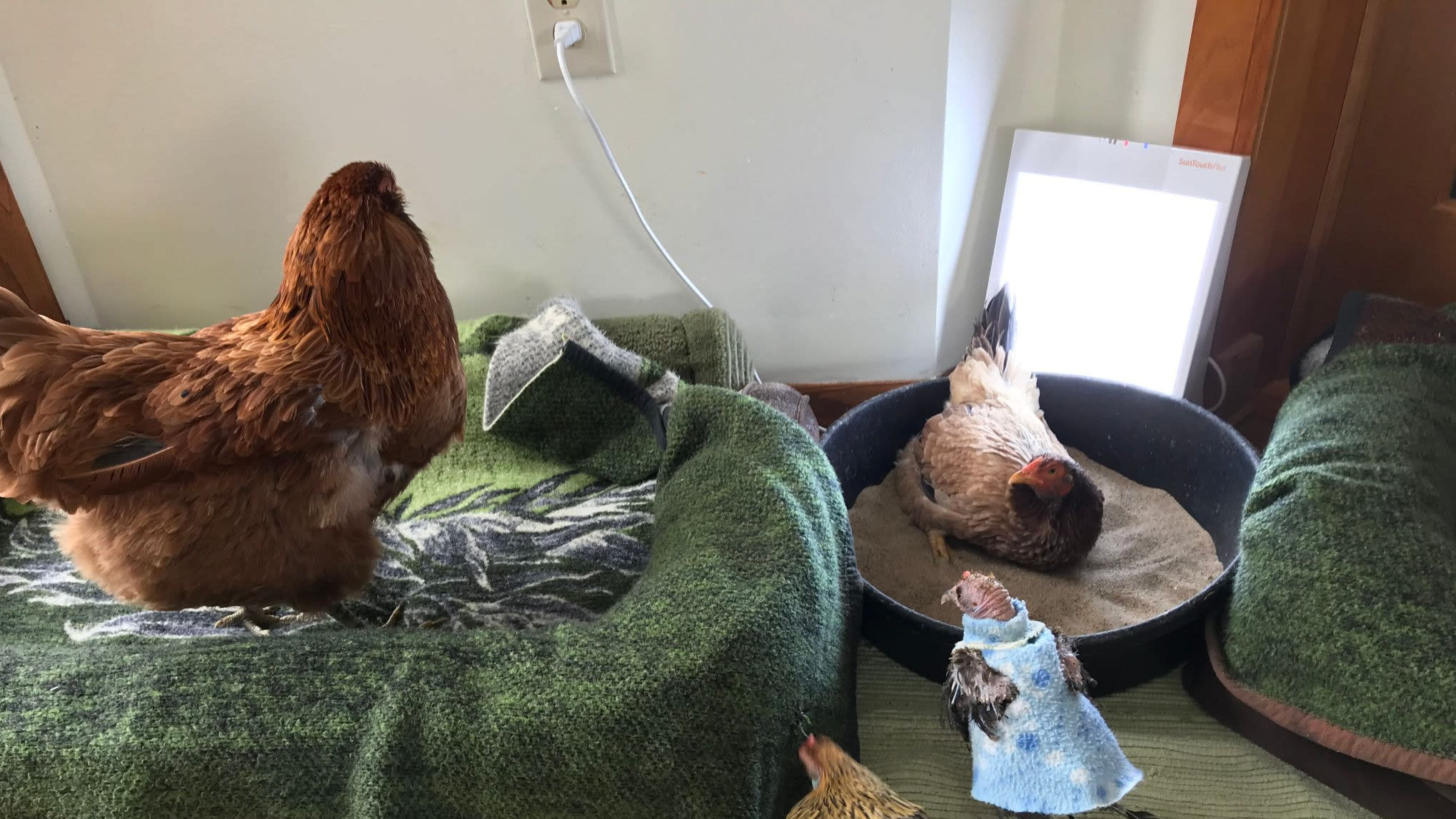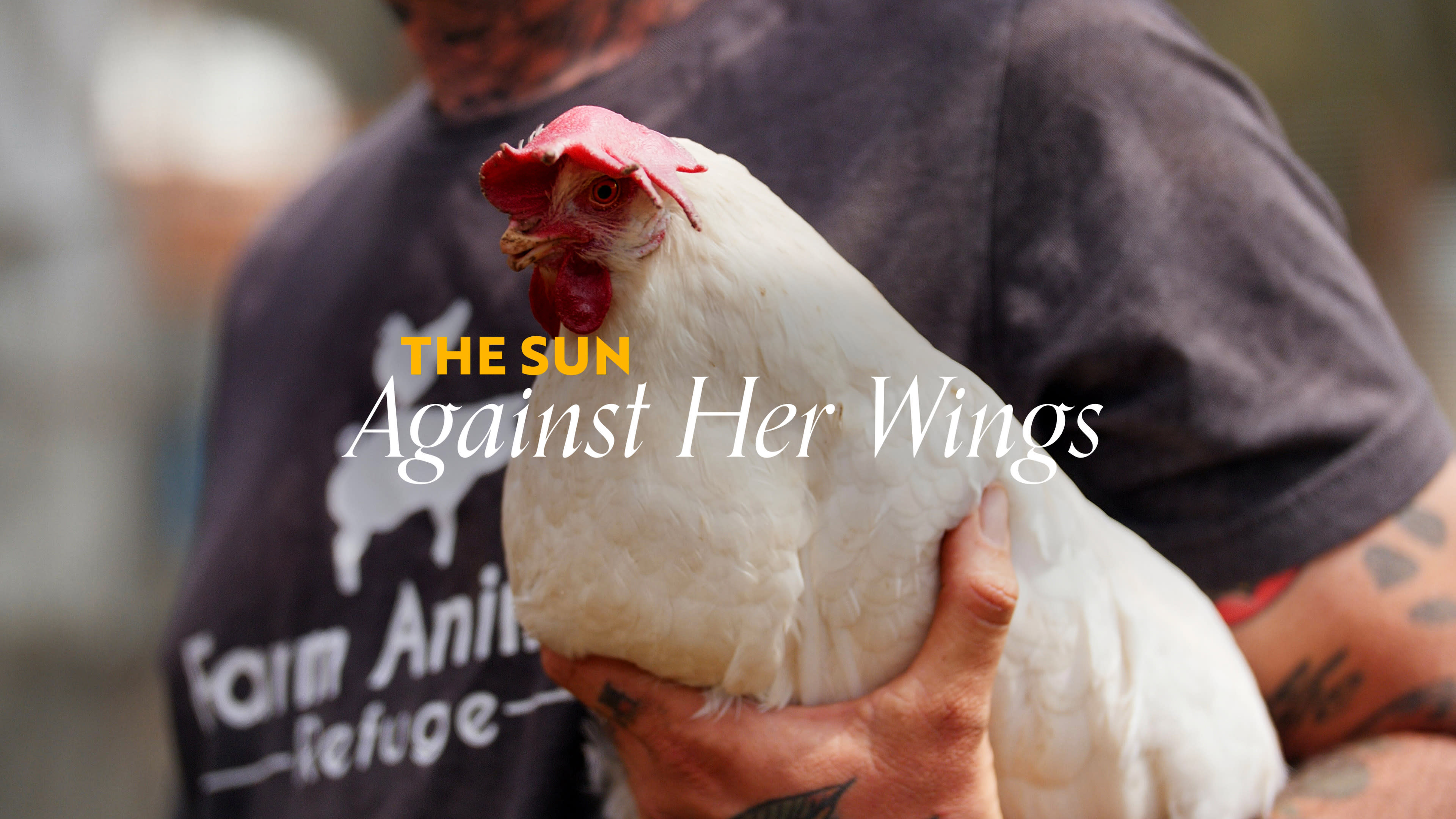




International Respect for Chickens Day is a reminder that farmed birds are caring, extraordinary individuals. Here's what it looks like when they're given the freedom to live—and thrive.

As International Respect for Chickens Day approaches on May 4, I’m remembering the first bird I knew by name—Rori.

Rori lived at SoulSpace Farm Sanctuary in New Richmond, Wisconsin. He looked like a big fluffy black ball, with feathers sticking out in all directions. Rori was assertive and protective. At feeding time, he would strategically guard the food—fending off the advances of other males—and then share the bounty with his female friends. Rori taught me that chickens are thinking, feeling beings with unique personalities.
Farmed birds like Rori face a grim reality on a global scale. Increased consumption of animal products worldwide has resulted in more intensive farming of chickens and other animals used for food. Egg-laying hens often spend their lives in a cage with floor space roughly the size of a standard sheet of paper. More than eight billion chickens and 250 million turkeys are killed for meat each year in the US alone.
Perhaps more than any other geographic region, the American Midwest is known for farming birds. Iowa produces more chickens than any other state, and Minnesota produces the most turkeys. But at Midwestern farm animal sanctuaries, chickens and turkeys with vibrant personalities challenge human assumptions about birds raised for food. As rescued birds flourish under the compassionate care of sanctuary stewards, they captivate the hearts and minds of visitors, social media followers, and others who have long thought of chickens and turkeys to be nothing more than a meal.
International Respect for Chickens Day exists to promote compassionate treatment of chickens and other domestic fowl. In honor of this occasion, we’re celebrating the legacies of a few late birds with big personalities who lived out their lives in sanctuary. These are the remarkable stories of a few lucky birds who made a lasting impact on those around them.
Lunaris of Chicken Run Rescue - Twin Cities Metro, MN

In 2016, animal control in St. Paul, Minnesota took in a stray. The individual was in such poor condition that they could not determine the species. They suspected the animal may have been a chicken, so they reached out to Mary Britton Clouse of Chicken Run Rescue (co-founded by Bert Clouse). Britton Clouse confirmed the individual was a chicken, despite her unusually small size and lack of feathers.
Soon, Chicken Run Rescue agreed to adopt the bird, and named her after the animal control officer who saved her—(Molly) Lunaris. Lunaris became the 1,039th bird rescued by Britton Clouse and her husband.
After coming to Chicken Run Rescue, Lunaris’ condition quickly improved, and she grew feathers. But some time later, she lost them again. She was diagnosed with lymphoma and a serious immune condition that would make it impossible for her to grow normal feathers. As a result, Lunaris needed to wear frocks to stay warm and to protect her fragile skin. Britton Clouse shared a pattern on Facebook so that admirers could make frocks for Lunaris.
“She had over 30 lovingly handmade dresses,” Britton Clouse says. “We didn’t dress Lunaris to be cute. Animals don’t enjoy wearing anything but what nature intended. We developed garments that were comfortable for her and did the job they needed to do. If they happened to be delightfully darling, so be it.”
Lunaris was incredibly shy at first. But soon she gained confidence and started discovering her favorite pastimes, including taking dust baths and seeking out treats. But Lunaris’ biggest passion was light. “She was mesmerized by and drawn to light—sunlight and artificial—and would seek out every shaft of light,” Britton Clouse says, noting that light therapy can help humans with similar skin conditions. “Animals instinctively know what their bodies need.”
Reflecting on why Lunaris had so many adorers, Britton Clouse says that “she had an ethereal quality that moved everyone who saw her as she lived the best life she could in spite of her physical challenges. She was radiant and beautiful in her imperfections."
When Lunaris died, as is customary at Chicken Run Rescue, Britton Clouse laid the bird’s body out for the other avian residents to “visit, understand, and mourn.” Reflecting on this ritual, Britton Clouse notes that “every bird reacts differently according to their relationship with the deceased. It is incredibly moving to witness.”
To this day, Britton Clouse still receives messages from supporters inspired by Lunaris. A garden at the sanctuary, which was established shortly before Lunaris’ passing, is now named in her honor: “Lunaris Landing.”
Eddie of Heartland Farm Sanctuary - Stoughton, WI

On Alecia Torres’ first day volunteering at Heartland Farm Sanctuary, she felt a pecking at her back. She turned around to see a massive, spectacular turkey named Eddie. “He was trying to get my attention, so he could show off,” Torres recalls.
Some time later, one of Eddie’s female turkey mates died. ”He went into a deep depression,” says Torres, who is now Shelter Director at Heartland. “He went into a corner of the barn and he stayed there and wouldn’t come out. He was so different from the happy, joyful guy I had first seen. We would spend a lot of time taking food to him, otherwise he wouldn’t eat. He wouldn’t go outside. He was there for weeks, just so devastated. When he came out of that period of mourning, he bonded super closely with the three of us who had taken care of him during that time. He thought we were his mates. He would always act that way with us, displaying his feathers and seeking us out in the barn and protecting us.”
Witnessing Eddie’s grief changed Torres’ perception of the inner lives of birds. “They feel such strong emotions, just like people do,” Torres says. “I gained this awareness that they have such rich emotional lives. Their feelings are just as significant to them as our feelings are to us.”
Years later, Eddie’s health started to decline. As he lost mobility, the staff moved him into a trailer on the property that functioned as an office. Soon, Torres and her colleagues decided it was time to help Eddie pass on.
“For the two nights before he died, I slept in the trailer to spend that time with him. The night before he was euthanized, I laid on the floor with him, and he laid next to me. When he was euthanized, the other woman who was close to him held him and I sat next to him, looking at his face and just being with him. It was very peaceful. And it was really hard. I felt the same way when we had our 13-year-old dog euthanized.”
Eddie’s death sent Torres into a profound state of grief. “The whole year following his death felt like the death of a family member. It was that hard. I thought about him every single day, and I missed him every single day,” Torres says. “Eddie taught me that turkeys are fiercely loyal, caring, intelligent and brave. He is one of the most loyal friends I have had in my life.”
Alfalfa of Rooster Redemption - Center City, MN (now Skagit County, WA)

At just six weeks old, Alfalfa was slated to be sacrificed as part of Kaporos, an annual atonement ritual practiced by some Orthodox Jews. But, in a miraculous twist of fate, Alfalfa was one of the lucky few rescued birds. Activists brought Alfalfa from New York to Minnesota so that he could live out his life peacefully at Rooster Redemption, a sanctuary which now operates in Skagit County, Washington.
During his first winter in Minnesota, Alfalfa lived indoors alongside Rooster Redemption founder Melanie Moonstone. Moonstone quickly learned that Alfalfa had a larger-than-life personality. Alfalfa would “dust bathe” in the dog bed. He would stand in front of the windows to bask in the sunshine and let his eyes close slowly with contentment. When Moonstone would open the refrigerator, Alfalfa would come running and poke his head inside. Once Moonstone chose something to eat, Alfalfa would want a bite too.
But Alfalfa was more than just a colorful character. He was also a crucial source of emotional support for Moonstone.
“Alfalfa taught me that I could get through anything,” Moonstone says. “He helped me through a divorce in 2019. He was always there to make me smile. He would stand and preen very close, sleep very close [to me], and sometimes stand on my foot.”
At two and a half years old, Alfalfa developed a mass on his lung, which led to a respiratory infection. He did not respond to medications quickly enough. He died peacefully at home with Moonstone and her partner on February 3, 2021.
“I made a memorial for him that includes some of his ashes and a feather from the poof of feathers he had on top of his head. It hangs on the wall in our bedroom. The rest of his ashes were spread in our memorial garden at a gathering we held for multiple birds who had passed, so our supporters were involved in laying him to rest,” Moonstone says. “I love you, Alfalfa. You were not a religious ritual, you were not food, you were not an experiment. You were a perfect innocent being, and we are honored to have lived with you.”
Hank of Spring Farm Sanctuary - Long Lake, MN

In 2023, Spring Farm Sanctuary founder Robin Johnson received a call about a domesticated turkey wandering the streets of a small town in Minnesota. Little did she know, the bird—who was later named Hank—would become one of the most beloved residents of her sanctuary.
At 56 pounds, Hank’s remarkable size was matched with an equally big personality. From the start, Hank made himself right at home at Spring Farm. He would follow Johnson and other caretakers around the grounds as they did their chores.
Hank quickly bonded with a resident cat at the sanctuary named Clover. “When Clover jumped into Hank’s run, the two of them would walk together, brush up against each other, and lay in the sun together. They were great friends,” Johnson says.
Hank only lived for about a year at Spring Farm Sanctuary before he passed away in 2024. During his short time at the sanctuary, he touched many hearts. According to Johnson, Hank was a favorite resident of visitors to the sanctuary.
“Our visitors loved seeing him up close and watching him as he responded to his name. Hank would softly coo while being pet on his head. People saw that and realized he was a sentient being, not a sandwich."
Visitors also enjoyed observing Hank’s color changes, which corresponded to his mood. When he was calm and quiet, his head and throat were blue. But if he got upset, like when he wanted more food, he turned bright red.
“He was fun to spend time with. He loved being pet and cared for. All of his caregivers and I miss him terribly,” Johnson says.
Building a better future for birds
Each of these birds embodies a unique story of triumph over adversity, and serves as a testament to the transformative power of sanctuary. While most chickens and turkeys are slaughtered at only 6-14 weeks old, these five rescued individuals give us a rare window into the beauty that unfolds when birds are allowed to live out their lives in peace. Rori, Eddie, Lunaris, Alfalfa, and Hank opened hearts and minds to the truth that all animals deserve kindness. These rescued individuals shed light on the complex inner lives of birds and the profound connections possible between humans and our feathered friends.
By reading and sharing the stories of these legendary birds, you play an important role in honoring their lives and acknowledging the sentience of all animals. Thank you for celebrating their legacies.






